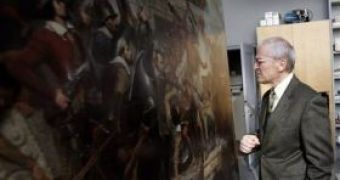Art forgery dates back more than two-thousand years. Roman sculptors produced copies of Greek sculptures. Presumably the contemporary buyers knew that they were not genuine.
Art restoration is a process that attempts to return the work of art to some previous state that the restorer imagines to be "original". This was commonly done in the past. However, in the late 20th century a separate concept of conservation was developed; that is more concerned with preserving the work of art for the future, and less with making it look pristine. Restoration is controversial, since it often involves some irreversible change to the original material of the artwork with the goal of making it "look good."
Trinity College chemistry professor Henry DePhillips is among a cadre of specialists using cutting-edge science to solve the color mysteries of paintings and other cultural treasures often several centuries old.
Many museums, art collectors and auction houses are increasingly turning to DePhillips and other experts to analyze artwork that has deteriorated over time. With tiny samples invisible to the naked eye, they use special microscopes and other equipment to sleuth out the compounds that comprise the color pigments and materials.
The result: a glimpse into the long-ago artist's materials and methods and a road map to preserve or restore the piece as close to its original state as possible.
"The whole goal of art conservation is to preserve the original vision of the artist, not my vision of what it could or should be," said DePhillips, who also uses chemistry to sniff out frauds as an authentication specialist. "If you're going to restore a piece of art to the way it was on the day it was finished, you need to know exactly what materials they used."
Until a few decades ago, most restoration and preservation was done by artists who used their best guesses on the original paints, varnishes and other substances used by the creators.
The results were sometimes good, but more often simply adequate, or, in the worst cases, left obvious signs such as mismatched blotches or brush strokes.
Using minuscule samples from the pieces, chemists can now pinpoint the blends of iron oxide, mercury, titanium dioxide, lapis lazuli and other substances that make up certain colors.
Mercury, for example, is the key to the reddish-orange hue of vermilion.
And even when a painting's cloud seems dingy, the presence of titanium dioxide proves that when it left the artist's easel, it was the bright white associated with that substance.
The implications of these applications go beyond aesthetics to cold cash. For example, the use of pure Prussian blue - the first synthetic color of the Industrial Revolution - can cause a painting's value to skyrocket.
The fact that experts do not always agree on the authenticity of a particular item makes the matter of provenance more complex. Some artists have even accepted copies as their own work -Picasso once said that he "would sign a very good forgery". Jean Corot painted over 700 works, but also signed copies made by others in his name, because he felt honored to be copied.
Occasionally work that has previously been declared a forgery is later accepted as genuine (Vermeer's Young Woman Seated at the Virginals had been regarded as a forgery from 1947 until March, 2004, when it was finally declared genuine), but for every art form, science is an invaluable tool in detecting fraud and preventing time from destroying mankind's masterpieces.

 14 DAY TRIAL //
14 DAY TRIAL //